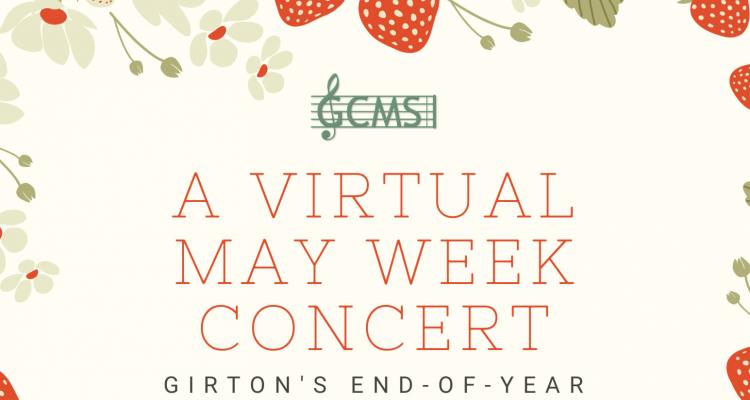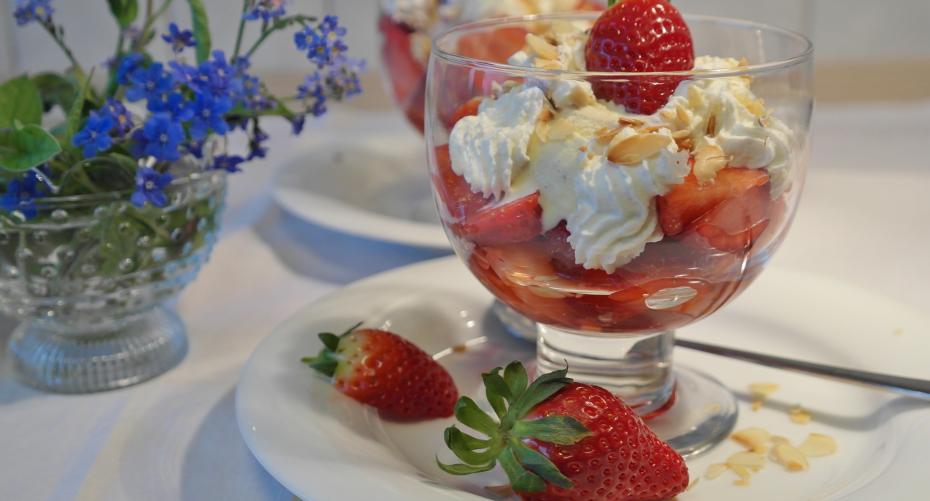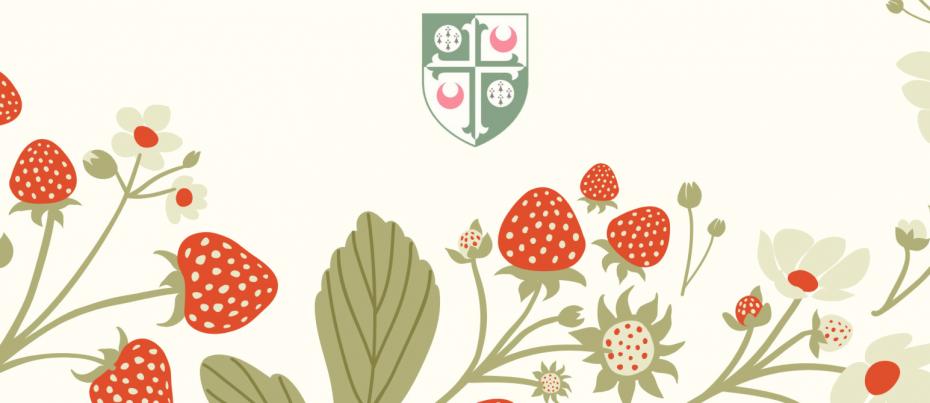Events
A Virtual May Week Concert

Welcome
Bach’s six violin and keyboard sonatas were most likely composed during his Cöthen period (1717–1723). The sonatas are unusual in that the keyboard part is written out by the composer; most contemporary works for this combination consist of two staves of music – one for the violinist, the other a bass-line to be realised, in all likelihood, on the harpsichord. Here, the keyboard is assigned two independent contrapuntal lines; together with the violin part these create the texture of a trio sonata. The Largo is in a simple binary form; the swinging dotted rhythms of the violin suggest the siciliano, an Italian dance.
Prelude and Fugue in G Minor, BWV 535 – J. S. Bach (1685 – 1750)
James Mitchell (organ)
The Prelude and Fugue in G Minor, BWV 535, exists in two substantially different versions, possibly up to twelve years apart. The version presented here, the later version, is more expansive. The opening prelude is a florid display of arpeggio figuration and seamless runs. The fugue theme appears briefly in the prelude as the first notes in the pedals; the fugue proper extends this subject. The repeated notes and intervals suggest the influence of earlier German organists such as Nicolaus Bruhns and Dieterich Buxtehude. However, the fugue is just as free as the prelude: free voice-leading abounds, and the work concludes with a brief cadenza before a final flourish.
Suite in D minor for solo cello, BWV 1008, arranged for viola, Prelude - J. S. Bach (1685 – 1750)
Robert Jones (viola)
Sandwiched between the famous G major and the youthful C major suites, Bach’s second suite for solo cello is set in the sombre key of D minor, taking a markedly serious take on the Baroque dance suite. The expressive opening Prelude comes in waves of emotion that reach ever higher, culminating in a moment of catharsis for both performer and listener. This arrangement replaces the gruff sound of the cello with the mellow tones of the viola, providing an opportunity for a particularly subtle range of expression.
O sacrum convivium, with divisions by Timothy Roberts - Andrea Gabrieli (c. 1533 – 1585)
Jeremy West (cornett) & Gareth Wilson (organ)
The text of this piece, attributed to St Thomas Aquinas (mid 13th century), was set to music by Andrea Gabrieli in 1565, shortly before his appointment as Director of Music at St Mark’s, Venice. Gabrieli may have used it as a part of his application to that post as it is unquestionably an exquisite Eucharistic motet. Originally set for five voices (possibly performed with instrumental support from cornetts and sackbutts), here the four lower parts are played on the organ while the top line is taken and elaborately embellished by the cornett. Text: O sacred feast in which Christ is received, the memory of his passion is renewed, the mind is filled with grace, and a pledge of future glory is given to us. Alleluia.
Trois pièces, iii Toan-Yan - Pierre-Octave Ferroud (1900 – 1936)
Lloyd Hampton (flute)
Each of Ferroud’s Trois pièces draws inspiration from different aspects of Chinese culture. Toan-Yan, subtitled La Fête du Double Cinq, or ‘the festival of the double five’, depicts the Dragon Boat Festival, which falls on the fifth day of the fifth lunar month, according to the Chinese calendar. (In 2020, the festival takes place on 25 June.) As well as improvisatory and spirited sections, the piece features an authentic Chinese melody, and the performer is directed to imitate a traditional Chinese flute.
Variations on a Theme by Paganini, Op. 35, Book I - Johannes Brahms (1833 – 1897)
Nicholas Maier (piano)
Brahms wrote his two books of variations on a theme by Paganini in 1863. He was not the first – or the last – to write a set of variations on Paganini’s famous twenty-fourth Caprice, but his collection contains perhaps the most comprehensive sequence of technical challenges inspired by that theme. The piece offers a summary of many of the techniques Brahms used throughout his output; it is a well-balanced meeting-point between the étude and the concert piece.
Sonatine en trio, Op. 85, Très lent – Animé - Florent Schmitt (1870 – 1958)
Lloyd Hampton (flute), Maddy Morris (clarinet) & Louie McIver (piano)
Educated at the Paris Conservatoire by, among others, Gabriel Fauré, Florent Schmitt is best remembered today for his large-scale orchestral works. His Sonatine en trio (1935) shows a more delicate and playful side to his music, while still exuding French elegance. Although originally written for flute, clarinet and harpsichord, versions of the work survive for flute, clarinet and piano, and for violin, cello and piano. The third movement is spacious and lyrical, while the fourth is filled with musical wit.
INTERVAL
Vins et fraises selon son goût

Vals, Op. 8 No. 4 - Agustín Barrios Mangoré (1885 – 1944)
Kevin Loh (guitar)
The Paraguayan virtuoso guitarist and composer Agustín Barrios Mangoré wrote his celebrated 4 Valses, Op. 8, under the clear inspiration of Chopinʼs piano waltzes. The fourth Waltz, in D major, is written in a quasi-Viennese style, though with Latin American flair. Barrios Mangoré uses the guitar in his own distinctive way to create an atmosphere of enchantment and romance.
I will never leave your side - Rachel Hill (b. 1999)
Rachel Hill (voice and guitar)
- Listen to MP3 (file coming soon)
Paper people - Rachel Hill (b. 1999)
Rachel Hill (voice and guitar)
- Listen to MP3 (file coming soon)
You’ve lost me (acoustic) - Rachel Hill (b. 1999)
Rachel Hill (voice and guitar)
- Listen to MP3 (file coming soon)
Rachel is an acoustic singer-songwriter working within a fluid musical genre mostly commonly described as ‘folk-pop’. Her music draws on influences such as Passenger, Masie Peters, Birdy and Gabrielle Aplin. Having studied classical singing from a young age, Rachel draws particularly on her unique high notes which characterise most of her music; her lyrics have been described as ‘witty, catchy and deeply personal’. Her debut EP Through Rain or Snow was released on 27 January 2020; it features five original songs.
Chanson russe - Igor Stravinsky (1882 – 1971)
Jemma Starling (violin) & Sam O’Neal (piano)
Jemma Starling (violin) & Sam O’Neal (piano)
This ‘Russian Maiden’s Song’ was transcribed for violin and piano in 1937 by Stravinsky in collaboration with the celebrated violinist Samuel Dushkin. It is based on an aria sung by the character Parasha, a Russian maid, at the start of Stravinsky’s comic opera Mavra; in it Parasha expresses longing for her lover. Stravinsky produced a number of other violin transcriptions and arrangements for Dushkin, including the ‘Divertimento’, based on music from Le Baiser de la Fée.
Concert Etude No. 6 (‘Pastoral’) - Nikolai Kapustin (b. 1937)
Louie McIver (piano)
Written in 1984, ‘Pastoral’, the sixth étude from a set of eight, is based primarily around a four-note motif which is transformed throughout the piece. It is a joyful work that demonstrates Kapustin’s impressive insights into jazz.
With you - Dave Stewart & Glen Ballard
Hannah Samuel (voice), James Mitchell (cello) & Louie McIver (piano)
‘With you’ is taken from Ghost, a musical based on the classic movie starring Patrick Swayze and Demi Moore. The song explores loss and the process of grieving for a loved one.
Amazing grace [Traditional]
Ailsa Critten & Rachel Armitage (trumpet)
Amazing Grace is a popular hymn first published in 1779 with words by the English poet John Newton (1725–1807). In 1835 William Walker assigned Newton’s words to a traditional song New Britain, creating the version we know today; this was published for the first time in 1847 in Walker’s ‘shape-note’ tune-book Southern Harmony. The arrangement for trumpet quartet heard here is by Andrew Reid.
O thou, the central orb - Charles Wood (1866 – 1926)
Girton College Chapel Choir & James Mitchell (organ), directed by Gareth Wilson
Charles Wood was born in Ireland in 1866 and received his earliest musical education in the choir school of St Patrick’s Cathedral, Armagh. He was among the first class of students at London’s Royal College of Music in 1883, before moving to Selwyn College, Cambridge, and later to Gonville & Caius, where he became that College’s first Director of Music. On Stanford’s death in 1924, Wood became Professor of Music at Cambridge. He is best known for the liturgical music he wrote for the Anglican Church. O thou, the central orb, a setting of a text also used by Orlando Gibbons, is one of his most-loved pieces.
Elsa’s Procession to the Cathedral - Richard Wagner (1813 – 1883)
Gir-Ten Brass: Rachel Armitage, Ailsa Critten, Tessa Doubleday, Dennis Lindebaum (trumpet); Jeremy West (horn); The Mistress, Catriona James (euphonium); Alex Liu, James Mitchell (trombone); Andrew Kershaw (tuba)
Elsa’s Procession, a fragment from Act II, Scene 4, of Wagner’s Romantic opera Lohengrin, is heard as the two main characters walk to Antwerp Cathedral where they will later be married. This version was arranged by Ian Shepherd and is a Gir-Ten lockdown recording prepared for Girton’s online graduation celebration in July.
Girton College Chapel Choir
Soprano
Ailsa Critten, Rachel Hill, Catriona James, Maddy Morris, Lisa-Maria Needham, Hannah Samuel and Jemma Starling.
Alto
Robyn Bartlett, Frances Conboy, Charlotte Howdle, Rosalind Skillen and Joe Wardhaugh.
Tenor
Oscar Ings, Kevin Loh, Luke Tutton and Deasil Waltho.
Bass
Thomas Beauchamp, Henry Colbert, Dennis Lindebaum, Louie McIver, Jasper Newbold, Sam O’Neal, Ben Pymer, Mark Sawney and Tom Williamson.

